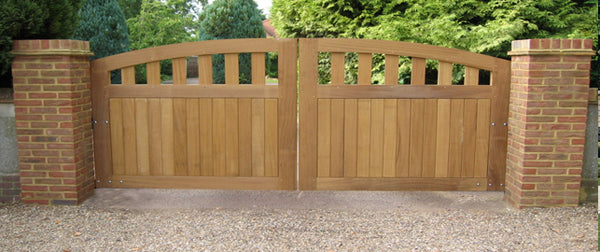Planning your gate automation
Site and Location
If I do not have gates or I think I might get new ones, what should I go for? SWING or SLIDING GATE?

The choice of gate is entirely up to you, but you will need to consider how and where the gates open - the arc of swing gates, the travel of the gate for sliding gates. You should also think about the size and weight of the gates - longer and heavier gates will cost more to automate. You need to consider practical matters such as vehicle movement/manoeuvring near the gate aperture (is the gate opening wide enough) and where vehicles will park and/or turn relative to the gate. A fair amount of planning should also be directed towards safety, such as where pedestrian can safely walk and what safety features will be required and where you will site them. For further information on safety please see below. To recap:-
- How will the gate open?
- What space will the gate occupy as it moves?
- What safety features will be used to protect vehicles and pedestrians?
- Is the gate aperture wide enough for vehicles turning-in?
- Is there sufficient room for vehicles to manoeuvre on the driveway and park without obstructing the gates or safety features (e.g. photocells or loop detectors)?
Do the gates exist already?
If you already have gates you are going to need to select the ideal gate opener to fit your gate.
You will need to know some the most relevant measures of your gates For swing gates you will also need to consider the maximum opening angle you will need to achieve; for sliding gates you will need to calculate the maximum travel:-
- Gate leaf length – How long is each gate?
- Gate leaf weight – How much does each gate weigh?
- Pillar dimension – how far are my gate hinghes mounted from the inner edge?
- Opening – Does it open towards inside or outside of the property?
Is the gate suitable for automation?
Does the gate move freely without overexertion or effort – i.e. can you open and close the gate with a light push? If the answer is no then the gate’s action needs to be remedied first. Automation motors are not designed to fight the gate, but move freely moving gates.
- Gate moves freely (no friction), opening and closing smoothly and noiselessly
- Gate is well balanced (i.e. once stopped in any position it does not show a tendency to start moving again)
- Gate stops are suggested for open and close positions.
Does the gate have a rising hinge?
If this is the case, it is unlikely you can automate the gate with its current hinge. Can the gate operate with a standard hinge after some ground work? If so then change the hinge to a standard flat action hinge. Rising hinges create vertical travel of the gate bracket, which currently no motor is designed to cope with (almost certainly breaking the motor or shearing off the bracket/damaging the gate).
What type of gate do you have?
There are a range of different motor types available that are suitable for different gate types, gate configurations and environments. We have outlined some motor options and considerations below to help you gauge what will be the most suitable for you:-
Swing Gates
shop for SWING GATE OPENERS NOW!

Linear /telescopic actuators

These are the most common type of gate motor. They are lower costing, reliable and simple to install. They use a worm drive or screw jack action to retract the arm, which shortens the arm length, thus opening the gates.
Underground motors

These swing gate motors are mounted in a case flush to the ground (foundation box) with the drive arm being affixed to the underside of the gate on the same axis as the hinge. They are discrete, offering improved gate aesthetics, but are generally more expensive than a linear ram equivalent. Because they are underground due consideration to drainage is a must. Ground work is required for installation, so plan ahead - allow enough time for concrete to set and drainage to be tested! Physically check your drainage before putting motors into the ground as IP65 is the industry minimum standard - meaning the motors can withstand spraying with a hose for 15 minutes but not immersion underwater!
Suitable for
- Most swing gates
- Discrete installations.
Unsuitable for
- Gravel/shingle drives
- Areas with poor drainage or a high water table.
Articulated motor

Using a hinged arm, articulated motors are ideal for ornamental gates, pedestrian gates, gates with large post/pillars that would obstruct a linear motor, and gates that need to open outwards (the polarity of the motors can be switched).
Suitable for
- pedestrian gates
- Gates with large pillars/posts that would obstruct a linear ram motor
- Gate that need to open outwards
- Wider opening angles (circa 130 degrees).
Unsuitable for
- Long and heavy gates

Sliding gate motors use a cog that is coupled with a toothed rack affixed to the gate. The cog turns, engaging the teeth on the rack, moving the gate in the desired direction. Sliding gates require either guide track and guide brackets/roller guides or a cantilever mechanism to ensure they move in a predicted manner. Limit stops and gate strikes are recommended to ensure the gate travel is restricted between precise limits.
When selecting a sliding motor you will need to consider the class of motor as the range of performance from small domestic 24v motors up to 3-phase industrial sliding gate motors is stark in terms of gate length/travel (the maximum opening distance), gate weight and operations intensity(how many times it can open/close in a given timeframe).
Suitable for
- All sliding gates
- Requires cantilever system when on a gradient.
Usage
DISCOVER ALL ADVANTAGES OF DC MOTOR EQUIPPED OPENERS
Safety
Protecting both pedestrians and vehicles from moving gates is a paramount consideration and there are a range of safety features and products that you can deploy to provide the safest environment possible for your automated gates.
LEARN MORE ABOUT DUCATI SAFETY SYSTEM
How will you get power to the gate?
Gate automation systems are electric so will require power at the gate. This can be provided by two sources:-
- Mains power –main ac power supply is connected to the toroidal transformer witch is included in each control unit to power 12V/ 24V DC openers
- Solar power – charging a battery systemfor 100% indpendance
So the first question you need to consider is how will power reach the gate – is there a nearby mains power supply you can use?
What ground work is required?
- Usually you will need a 200mm trench for armoured power cable to the gate
- Wired intercom systems – this will also need bell wire or exterior screened Cat-5 run to the gate – it is suggested these are place in conduit. It is advised they are buried at least 200mm distance from the power cable to prevent electrical interference
- Underground motor systems - Gate posts and foundation boxes will need to be set in concrete
- Sliding gate guide track will need to be set in concrete if you are not using a cantilever system
- Gate stops – if your gate does not have limit/gate stops then we always suggest using them regardless of whether your motor has built-in limits or not.
What else do I need to prepare?
The strongest piece of advice we can offer is to fully read the installation guides prior to purchase – watch our MANUALS
- Read the installation guides and instructions for all components of your system not just the gate kit as accessories and access control systems will also have specific requirements that may require preparation
- Discuss the project with your electrician/installer and ensure they are completely happy all the components you intend on purchasing prior to buying anything.
- Calculate how much cable you will need, how many junction boxes and how many relays to allow you to integrate your accessories and intercoms with the gate automation systems.
Help & advice
Can you advise me about what gate kit, accessories and access control I might need?
Certainly – contact us anytime. we are at your full disposal 7/24h

